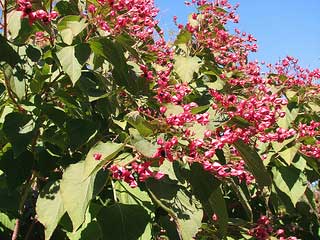Resource Library
Plant of the Week: Harlequin Glorybower
The University of Arkansas System Division of Agriculture does not promote, support or recommend plants featured in "Plant of the Week." Please consult your local Extension office for plants suitable for your region.
Plant of the Week
Harlequin Glorybower
Latin: Clerodendrum trichotomum

Bling abounds in our world. The flow of commerce is greased by beautiful, sparkly things that attract attention and make us lust for it. The plant world is no exception but sometime the beauty is fleeting and we’ve got to put up with some pretty unkempt plants before we experience the beauty. Harlequin glorybower (Clerodendrum trichotomum), now doing its thing in the fall garden, is such a plant.
There are about 400 species of Clerodendrum, most of which are found in the Asian and African tropics. They have long been considered part of the verbena family but recently were reclassified to the mint family based on DNA testing. Harlequin glorybower is native to eastern China and Japan and is one of the most cold-hardy of the genus, growing as far north in the US as zone 7 where it will often freeze back during cold winters.
Harlequin glorybower is a coarse textured deciduous shrub that grows to 15 feet tall but is usually 10 feet or less in zone 7. It tends to be sparsely covered with foliage at the base with 6-inch-long, heart-shaped leaves that, instead of developing fall color as would be proper and fitting, instead die green with the first frost. Leaves have a decidedly stinky nature when crushed. The leafy characteristics of the shrub are best considered homely at best. Once established plants tend to sucker freely much like a sumac, often with new plants emerging many feet from the original.
But then it flowers in late summer and all is forgiven. It blooms terminally with white, fragrant inch wide tubular, five-pointed blossoms produced in a 6-inch wide cluster. Long stamens protrude from each floral tube. An inch-wide star-shaped calyx that turns red as the blossoms mature subtends the flowers. In the center of the star – provided pollination has occurred – is a steel gray, turning to dark blue round fruit about the size of a pea. These showy fruit are the bling that makes putting up with a bit of untidiness worthwhile. Unfortunately, this species is self-incompatible, so to get fruit set two different clones are needed to achieve fertilization and fruit set.
Harlequin glorybower, as the pompous name indicates, was introduced during the Victorian era. It was introduced from Japan by Karl Maximovich (1827 – 1895), a Russian botanist who worked out of the botanical garden in St. Petersburg. Clerodendrum was collected in Japan during his 1860 – 1864 exploration of the Far East. Though not often heralded, Maximovich was one of the most important plant collectors who introduced hundreds of new plants to western gardens.
Harlequin glorybower grows from zone 7 through 10, doing best in a somewhat moist fertile soil in full sun or light shade. Its tendency to spread by underground suckers makes it difficult to use in the mixed border. A better solution is to plant it in a lawn area and train it as a small tree, staking it until the trunk is strong enough to support itself. If surrounded by lawn, any unwanted suckers can be easily controlled by mowing. ‘Betty Stiles’ is an introduction that is said to be more cold hardy and have a better form than the typical glorybower. A botanical variety called fargesii is the most cold-hardy and has been singled out in England as the best of these plants there.
By: Gerald Klingaman, retired
Retired Extension Horticulturist - Ornamentals
Extension News - September 6, 2013
The University of Arkansas System Division of Agriculture does not maintain lists of retail outlets where these plants can be purchased. Please check your local nursery or other retail outlets to ask about the availability of these plants for your growing area.